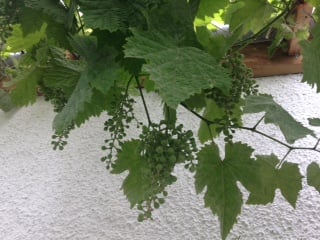My grape vine isn’t quite in my greenhouse, but it is in the next best place. I have a deck outside my back door, covered with polycarbonate sheeting to keep out the rain but let in the light. Here I have tried to emulate the vineries in grand walled gardens by planting the feet of my vine outside in the soil, but training the top of it in and under the cover. In theory this should make for the best possible conditions. The big, thirsty and greedy roots of the vine are always planted into the soil outside of a vinery, so that they are watered by the rain rather than by bucketsful of mains water a day, carried by the gardener, and so that they are free to stretch out their feeding roots into the more nutritious soil a garden offers. Likewise the cover means that there is plenty of light but no chance that this vine will get rained upon at the wrong moment: rain at flowering time can reduce vine flower pollination.
So here I have this perfect almost-under-cover set up and yet….no grapes. Or at least none that anyone would want to eat. They  start off well. At this time of year they look promising and luscious, hanging in perfect green bunches, and everyone who wonders out onto the terrace admires them and remarks upon my gardening prowess. They will not be allowed out there any time after mid July. The grapes swell a little more but then develop a flush of mould and start to crack. So this year I am taking a different tack: thinning them ruthlessly in the hope that a few develop, but also using the thinnings. I have long ago resigned myself to using the vine as a leaf crop, harvesting the young leaves to make dolmades. How brilliant if I can get a second crop out of them. If life gives you sour grapes, make verjus.
start off well. At this time of year they look promising and luscious, hanging in perfect green bunches, and everyone who wonders out onto the terrace admires them and remarks upon my gardening prowess. They will not be allowed out there any time after mid July. The grapes swell a little more but then develop a flush of mould and start to crack. So this year I am taking a different tack: thinning them ruthlessly in the hope that a few develop, but also using the thinnings. I have long ago resigned myself to using the vine as a leaf crop, harvesting the young leaves to make dolmades. How brilliant if I can get a second crop out of them. If life gives you sour grapes, make verjus.
Verjus means ‘green juice’ and is a very old ingredient, used to add sourness to dishes before lemons and other sour ingredients arrived in Europe. I occasionally buy a very expensive bottle from Waitrose, but it is marvellous that my disappointing crop can be turned into such an interesting ingredient.
Verjus
You will need:
Lots of unripe grapes, ideally about a bucket full.
1 tsp citric acid
First remove the stems, then put through a grinder or a food processor in batches, and pour the mash into a fine meshed sieve. Work quickly to prevent oxidisation, or your jus will be more marron than vert. Push the juice through the sieve and then strain again through a coffee filter. Pour the juice into a jar, stir in the citric acid and store in the fridge. After a couple of days sediment will have formed at the bottom of the jar. Carefully tip off the clear juice into a fresh jar, leaving the sediment at the base. The verjus should last for a couple of months if kept in the fridge.
I have used verjus in the past in salad dressings as a less astringent substitute for vinegar, and I quite fancy making it into a syrup and seeing how that sweet/sour balance works with fruit. It is particularly good as a sharp element in long-cooked and spicy dishes and with chicken. A little splash in a gin and tonic is quite magic too. I sense I could battle my vine forever, trying to make it produce the juicy ripe grapes that I dreamed of when I planted it, but this is an alternative harvest that is almost as good.


